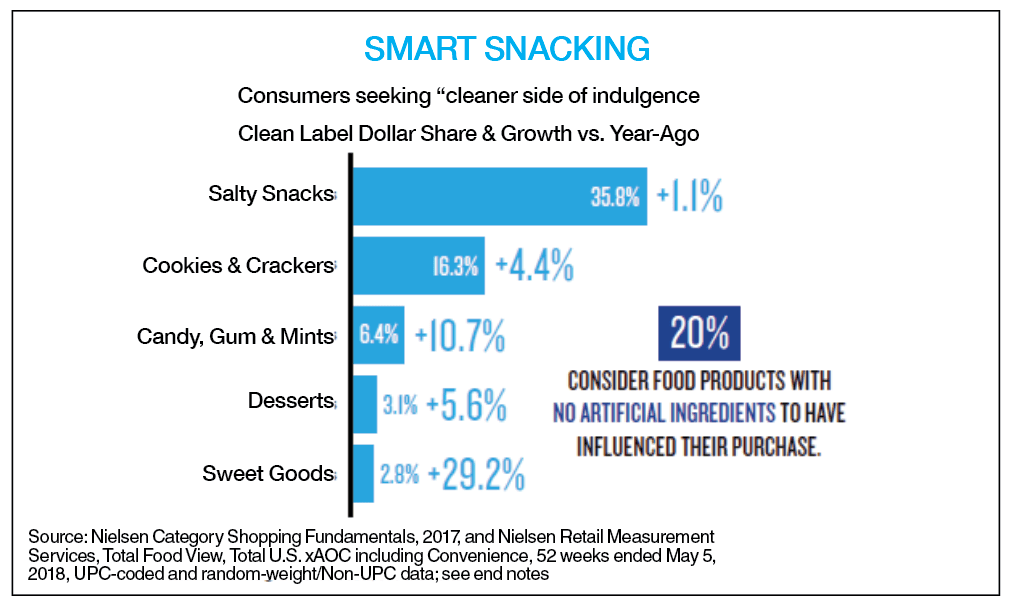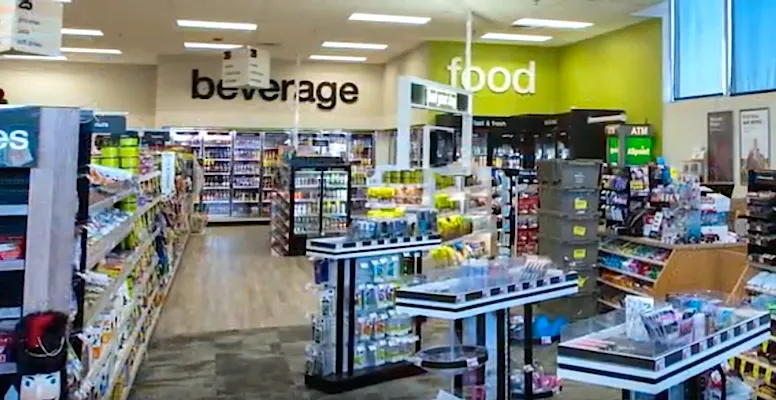
Sarah Schmansky
With sweeping changes occurring within the pharmacy and health care business landscape, it’s easy to lose focus on the front end of the store. However, efforts to create a healthy front end should not be ignored. In fact, now more than ever, it should be a top priority.
Why? Because the U.S. drug store channel is under pressure, under the spotlight and, for the year to date, underperforming. The latest 52-week data from Nielsen (for the year ended June 30, 2018) shows that across all departments the drug store channel is showing an overall decline of 1.2% in dollar volume and 4.4% in units, year over year. Packaged grocery, health and beauty, and tobacco/tobacco alternatives are three categories that are leading this decline.
Bright spots within the store are the frozen, produce and meat categories, all thriving due to healthy innovation in the frozen food space and the slow adoption of purchasing perishable items online, which is driving trips to brick-and-mortar stores.
In the face of declining sales and decreasing store doors, knowing what consumers want is just half the battle. Creating a healthy front end requires a total food view. Simply put, this means operating with a full picture of how consumers shop across all front-end aisles and categories — inclusive of UPC and non-UPC coded items — to help optimize business and capitalize on untapped opportunities. To meet the demands of today’s highly selective, savvy consumers, a broader, more connected approach to front-end category management, insights and measurement within this space is needed. In today’s consumer-driven market, making business decisions with an isolated category-driven view of the store can leave companies blind to emerging trends and synergistic opportunities within flourishing areas of the store.
Take for example, the snacking category. Within the drug store channel, the latest Nielsen data shows that snacking categories like salty snacks and candy, gum and mints have faced steep declines. Year over year, the candy, gum and mints category has experienced a 2.5% decline in dollars and a 6.4% decline in units, while the salty snacks category has seen a 0.9% decline in dollars and a 5.2% decline in units. While salty snacks are down in drug stores, across total U.S. food salty snacks within packaged grocery aisles have fared better over the past 52 weeks, seeing absolute dollar growth of more than $207 million year over year, resulting in 1.8% growth in dollars and 0.2% growth in units. By leveraging Nielsen’s Total Food View, we can dig a little deeper into trends, insights and hidden opportunities within this space to capitalize on what consumers are demanding.

With increasingly on-the-go lifestyles, Americans have shifted to a snacking culture of grazing — eating what they want, where they want and when they want, whether for a quick energy boost, to fuel themselves in lieu of a full meal or to indulge in a treat. Retailers and manufacturers are already profiting through portability by offering single-serve grab-and-go products to fit this consumer need.
From a health and wellness perspective, this movement has certainly taken hold of the snacking category, too.
With more and more drug stores embracing fresh food offerings and increasing the availability of produce in-store, it is a step in the right direction to better cater to today’s consumer preferences and needs. In fact, produce is one of the main drivers of channel growth. Within the last 52 weeks, data from Nielsen’s Total Food View shows that produce sales within the drug store channel netted $74 million, which is an increase of 1.8% from a year ago. Within the snack world, this translates to enabling consumers to easily swap out an indulgent bag of chips for a healthy apple. Simple win, right? Not so much. Nielsen’s most recent Total Consumer Report (June 2018), has shown that the snacking debate is shifting and is no longer just about healthy versus indulgent.
Across Nielsen’s AOC+C (all outlets combined, plus convenience stores) tracked outlets, sales of “on the go” fresh produce, a subset of value-added produce (aka pre-sliced fruit), have declined by nearly 2% in dollars and 6% in units over the last year. Conversely, when looking at sales of salty snacks across all channels, the category has seen nearly $1 billion in growth year over year — a prime example of an indulgent category that has adapted to consumer preferences and, as a result, has seen growth amidst countless healthful consumer crazes.
What does this mean? It reinforces the importance of knowing what your consumers want. It’s not enough to just have produce in the store. What matters is that you are carrying the right variety of produce that consumers will buy and eat. It also shows that in order to win consumers within the snacking category, being healthy alone is no longer enough.
Consumers are seeking indulgence in their snacking purchases, too. While Americans would rank eating more fruits and vegetables as the top factor for healthy eating, they are not flocking to on-the-go fresh produce offerings as much as they are to other snack options — a notable takeaway for drug store players.
Produce will continue to cater to the health-focused consumer, and will continue to be an important offering. Choosing the right produce assortment aligned with consumer demand is key.
Instead, opportunities for growth in snacking sit at the corner of healthy and indulgent. The path to this middle ground of good and bad is guided by transparent products manufactured in simple, sustainable and clean ways. Where consumers can feel reassured that they are avoiding undesirable or artificial ingredients, they can be enticed to treat themselves. In fact, “clean” products are driving outsized growth across many indulgent snack categories.
Retailers and manufacturers that can demonstrate cleaner practices through their labeling can capitalize on the wave of consumer interest around snacking responsibly.
A Total Food View snapshot of today’s snacking landscape shows that there is a new world order within the snacking space unfolding before our very eyes. For drug store retailers and manufacturers, there are untapped opportunities within this space to help better meet consumer needs, create a healthier front end, and make a lasting impression and experience to encourage repeat trips. Through a Total Food View approach, looking beyond your core areas of expertise can help you capitalize on larger trends and turn a low-growth or even stagnant market into one full of new and emerging opportunities.
Sarah Schmansky is vice president of Nielsen’s health, wellness and fresh practice. She can be contacted at sarah.schmansky@nielsen.com.









